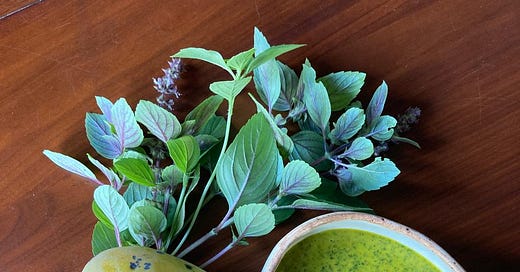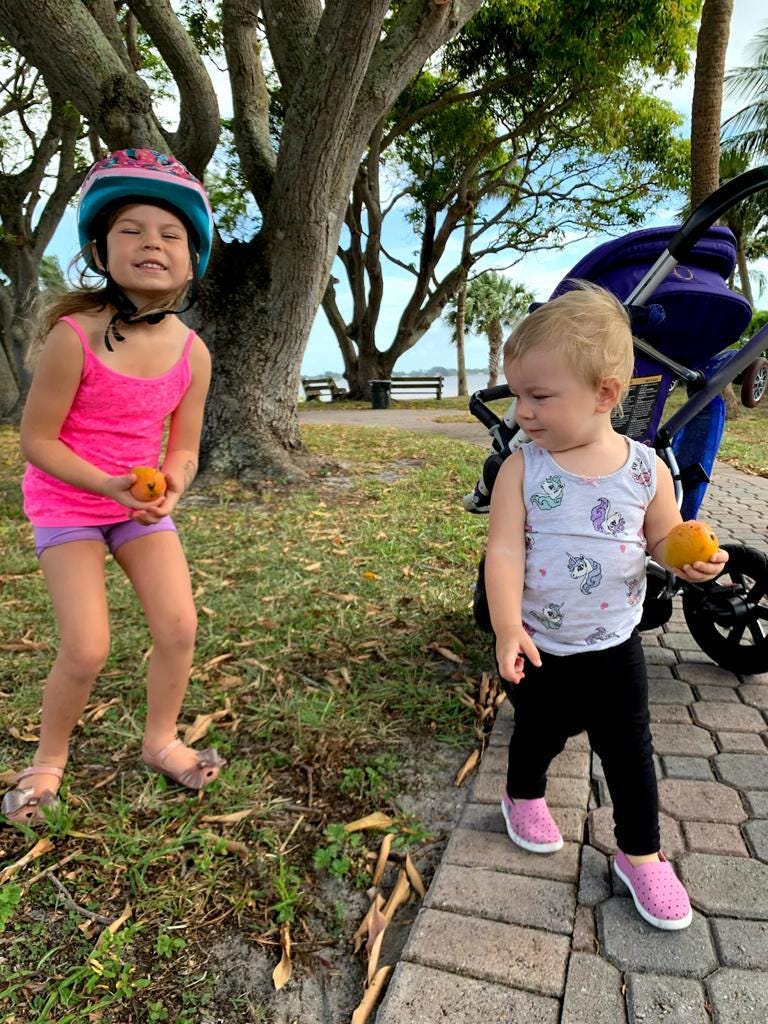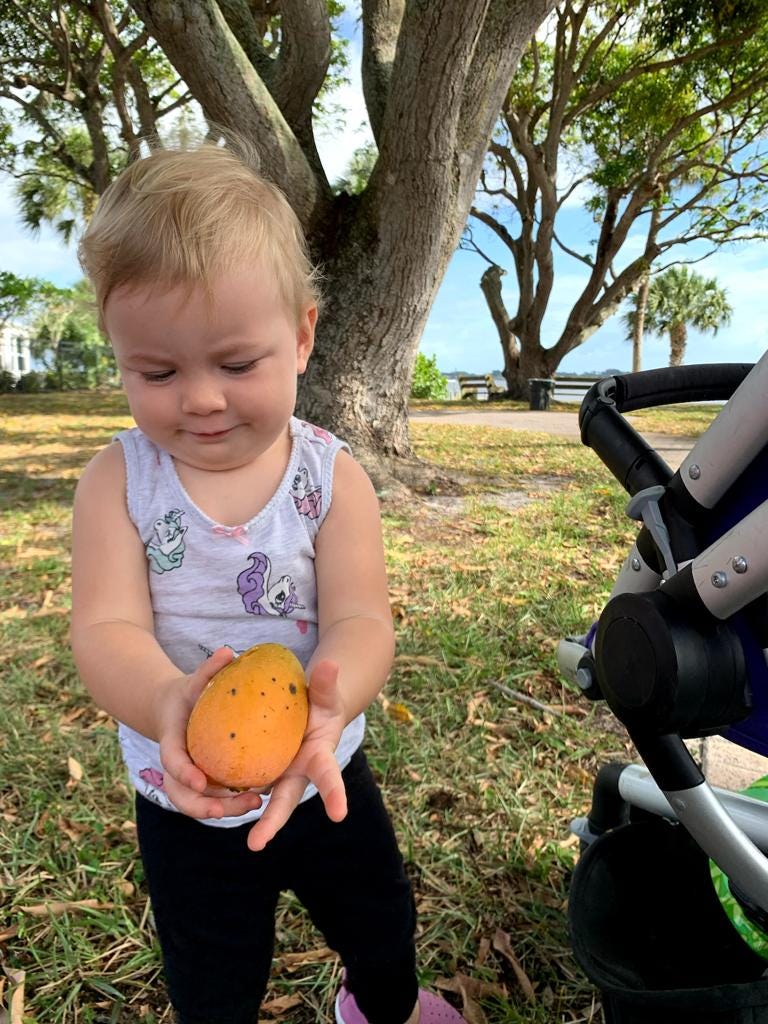Celebrate the 4th of July this weekend the right way: By gleaning mangoes and watching fireworks with friends (and mango sauce). Also, come see Jackie this Friday night from 5-9 at The Lotus Room Salon on in Downtown Stuart. She’ll have lovely glutenful treats to try and buy.
If someone shared this newsletter with you, subscribe here:
I’ve been blessed in recent weeks with an abundance of mangoes from some of the cool moms in my life. My mom, Matt’s mom, and my best friend Micah’s mom have gifted me extra fruit, and I’ve been dutifully peeling, chopping, and freezing it all. I’m dreaming of all the mango pie, mango lassi, and mango sorbet in my future, as well as the vinegar and tropical shrub I’ll be making from the pits and peels.
With so many mango trees in Martin County, the harvest really is a collective effort. My parents have seven towering mango trees in their backyard, producing more fruit than they could ever dream of consuming. All around town I notice the sheer quantity of fruit that will inevitably go to waste (even the birds and squirrels can’t eat it all!) and realize this calls for a well-organized community gleaning operation.
Gleaning is the act of collecting leftover crops from farms and other landscapes. This method of gathering food has long been a vital way to make it through lean times. Gleaning gets several plugs in the Old Testament, with God commanding farmers to leave the corners of their fields unharvested for the benefit of hungry neighbors who might stop by for a snack. It’s perhaps the only nice bit of advice in the otherwise 🤮 book of Leviticus.
Gleaning has traditionally been the purview of religious groups. In Florida, CROS Ministries in Lake Worth and the Society of St. Andrew in Orlando both organize gleaning of regional farms. Their volunteers deliver the food to food banks and pantries. But due to the global pandemic, gleaning has seen a surge in popularity. With a marked increase in hunger combined with supply chain chaos, gleaning groups have popped up around the country to attempt to solve both problems. Rachel Wharton writes for the New York Times about the wide variety of groups that have added gleaning to their tools used to fight food insecurity, from tech entrepreneurs to refugee groups to small nonprofits to botanical gardens.
“When you see how long the food lines are, it just kind of makes people realize that now we have to find the food that is already here,” said Virginia Baker, the part-time gleaning coordinator for Farmers Against Hunger. “We already have it. We just have to be able to get it into the hands of the people who need it.”
I joined a community gleaning outfit when I lived in London. The Transition Town group in my neighborhood organized volunteers for regular harvests of local trees. A person with a fruit tree in their backyard could contact our group for help with the harvest. Volunteers would get a share of the fruit in exchange for their labor. I enjoyed many lovely pear crisps, apple pies, and blackberry cobblers thanks to the backyard fruit I collected with the rest of my fellow gleaners.
Sadly nothing like this Transition gleaners group exists (yet!) on the Treasure Coast (shout out if you know about gleaning efforts elsewhere in Florida!). But there are many options for DIY gleaning. The website Falling Fruit is a crowdsourced map of urban fruit trees around the globe. Only five trees are listed in Martin County, so if you know of more publicly available fruit, add it to the map!
There is such a wonderful feeling of abundance that comes with mango season. I love biking around town and seeing the giant trees heavy with fruit on every corner. I love coming home to a grocery bag of ripe fruit a friend has left on my porch. I love having the time and freezer space to make sure as little as possible of the mango windfall ends up rotting on the ground. With all the publicly accessible fruit, we can all share in the joy of the harvest.
Here are some cute pics of my buddies Alice and Eleanor picking mangoes from a tree in a park in their neighborhood:
love,
Jackie
🧇 15 Hours Spent in Breakfast Purgatory | The Clarion-Ledger
Here’s a thought experiment: You’re trapped inside of a Waffle House for 24 hours. But for every waffle eaten your time in the restaurant is reduced by one hour. How long would you be in the Waffle House before you're free?
Lee Sanderlin, an investigative reporter at the Clarion-Ledger in Jackson, Miss., had to live out this scenario as his punishment for finishing last in his fantasy football league. A rapt audience followed along as he tweeted out his torture, praised the patient staff, and, yes, threw up behind a dumpster.


In the end, after seven waffles, several cups of coffee, a few podcast episodes and a failed attempt at a New Yorker crossword, Sanderlin made it out at 7:07 a.m. Fifteen hours after he had entered.
(Matt bets he could be out in 12 hours. Tops.)
👩🔬🍺 Women in the craft beer industry say they’re treated like they don’t belong. Now, they’re speaking up. | The Lily
When Brienne Allan, a brewer for almost a decade who specializes in lagers, wrote on Instagram about her frustrations with the industry she received an overwhelming response. She said, “hundreds of anecdotes came pouring in from other women in craft beer. Women detailed harassment, toxic masculinity and even allegations of assault at some of the most reputable breweries across the world.”
The craft beer industry is overwhelmingly white, male, cisgender, and straight. (Even though that wasn’t always the case, the original brewers in civilization were women). When women and people of color enter the industry they often find their abilities questioned and/or harassed by gatekeepers.
Craft brewing’s current #metoo moment has even forced the Brewers Association, the most prominent industry trade organization, to take notice. They’ve announced upcoming programs and events designed to address and prevent sexual harassment in the workplace and promote inclusivity. It’s a small step forward. Chantel Williams, a Black brewer in Seattle, who created her Instagram account Hops Galore “to connect with other marginalized people across the industry”, knows she’s in for a long fight to improve an industry long in need of change.
“I have heard ‘Women don’t drink beer’ or ‘Black people don’t drink beer,’” Williams said. “As a woman of color in an influencer position on social media, we have to fight harder to be taken seriously.”
Looking for a feel good novel about women who brew? Jackie recommends “The Lager Queen of Minnesota” by J. Ryan Stradal.
☀️PHOTOS: The Record-Breaking Heat Wave That's Scorching The Pacific Northwest | The Guardian
The Pacific Northwest is experiencing an unprecedented, lethal heat wave right now, and the numbers are eye-popping. Eric Holthaus wrote in The Guardian that “Seattle’s new all-time record of 108°F, also set Monday, is hotter than it’s ever been in Miami. In Portland, the new record of 116°F would beat the warmest day ever recorded in Houston by nearly 10 degrees.” The entire village of Lytton, British Columbia, is being evacuated due to fires started after the city reached 118°F — a record for Canada.
Climate change makes both heat waves and droughts more common and more intense. And the “heat dome” encompassing the Pacific Northwest right now is even scarier for residents since most people don’t have air conditioning in their homes, as summer temperatures usually don’t go higher than the 70s. Perhaps the best way to comprehend this historic heatwave is through these images, which demonstrate the power of scorching heat.


Brett's Mango Basil Sauce
My friends Brett and Mimi had me over for dinner last week. The table was laid with a gorgeous spread of food, but the star of the show was this mango basil sauce. Brett bribed the recipe out of a chef at The Flying Otter Grill in Victoria, B.C., and boy am I glad he did. It’s super simple to make and seriously, it works with everything. I’ve already mixed it into pasta with cherry tomatoes, slathered it on roasted fish, drizzled it over vanilla ice cream, and dipped bread into it. Go get your gleaning on and whip up this sauce post-haste!
Makes about 2 cups
Ingredients
1 ripe mango, peeled and cut into rough chunks
1 cup packed basil leaves (play around with different varieties of basil...a lemon-lime would be AMAZING)
1-2 tablespoons olive oil
1-2 tablespoons lemon or lime juice or apple cider (or other light) vinegar
1 teaspoon salt, plus more to taste
Black pepper to taste
Step by step
Place all ingredients in a blender and blend until smooth. Taste and adjust flavor as needed.
Variations:
Replace half of the mango with pineapple
Add thin slices of lemongrass, ginger, and/or turmeric
Add a fresh hot pepper or two
Add red onion and garlic for a more savory version
Cat thief caught egg-handed 🥚🙀
Talk to Us
Send in your comments, mailbag questions, recipe mishaps, or cooking tips: sunshineandmicrobes@gmail.com. Also do us a favor and follow us on Facebook and Instagram. Visit our website and cook yourself something nice.
If you enjoyed this email, please share it with others. If someone forwarded this to you, click the button to sign up:
----------------------------------------------------------------------------------------
Sunshine + Microbes team
Jackie Vitale is a cook and kitchen educator based in Stuart, Fla . She runs Otto’s Bread Club and is co-founder of the Florida Ferment Fest. Her newsletter explores the intersection of food, culture, environment and community.
Matt Levin is a communications strategist at the ACLU of Texas. He edits Sunshine + Microbes and contributes other scraps to each issue.













